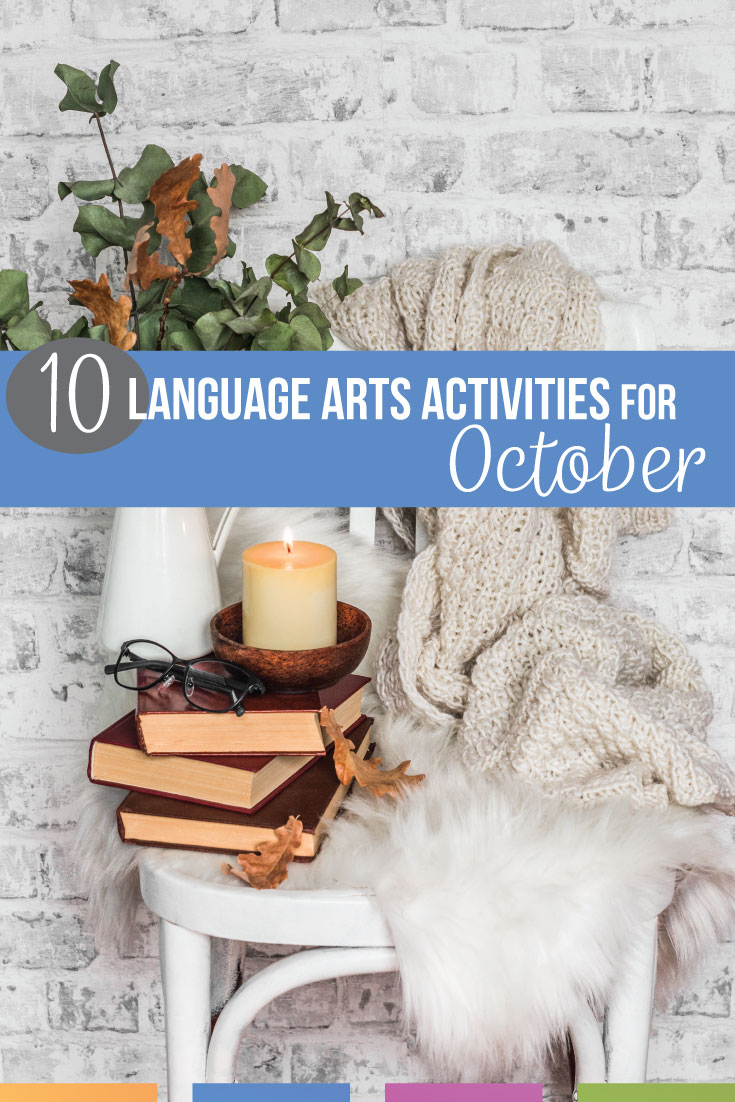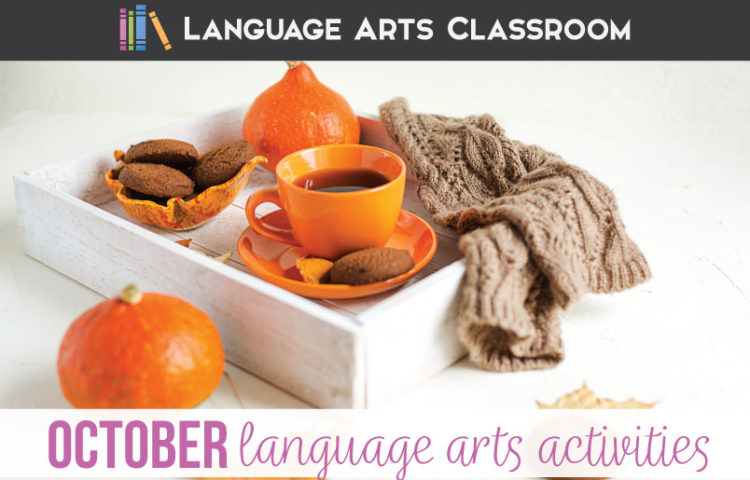October language arts activities: have fun with your secondary students while still providing meaningful lessons.
As a teacher, you want students to enjoy the seasons. They are, after all, still kids.
As a teacher, you want to cover your lesson plans too. Hence, the balance.
Students love fall holidays, and I do too. Use that emotion to your advantage. Have students write about the changing environment. Take them outside to experience glorious fall and work their vocabulary. Fall lessons for language arts can be purposeful and part of your curriculum.
I find the second quarter of school to be a “sweet spot.” Students understand routines and procedures, but they aren’t tired yet. I personally still have energy and that excited spirt to create a memorable school year. Plus, I am excited for fall language arts activities, and my students are too.

During October, I’ve found that incorporating the season into lessons helps with classroom management. The lessons don’t feel forced, and I find that the setting outside the window lends itself to my lessons inside my room. Here are October language arts activities.
Read fall-ish stories.
Read a few spooky stories; reading Edgar Allan Poe is a part of my October curriculum. “The Masque of the Red Death” is my personal favorite, but I know many teachers use “The Black Cat” too. Gothic horror stories like “The Monkey’s Paw” fit in nicely as well.
Specifically, I tie grammar to short stories or poems. “The Raven” is a perfect opportunity to study verbals (I do that with sophomores), and “The Cask of Amontillado” works well with adjectives.
I know that not every school celebrates Halloween. If your community does not, you could read First Chapter Friday books that are set during autumn like The Haunting of Hill House, Little Women, or The Catcher in the Rye. Perfect poem: “When the Frost is on the Punkin.”
Give a how-to speech.
Encourage student excitement with a speech. What makes fall special? Many students realize that their reasons change over time. At one point, they liked Thanksgiving because holidays with gifts were next. As they become more mature, they enjoy the family and traditions of Thanksgiving more. Ask students to explain their family or community’s process for the seasons.
Often, a how-to speech focuses on preparing food. Switch up that expectation! Ask students to explain how to design a costume, how to practice for a certain sport, or how to balance work and school. A how-to speech doesn’t need to involve food, but it certainly can.
Teaching grammar: parts of a sentence.
With freshmen during October, I am teaching parts of a sentence. During the first two months of school, I review parts of speech and connect the ideas with vocabulary. As I teach subjects, verbs, and on, I am building toward more advanced concepts like punctuation with phrases and clauses. We never stop using those terms as it is important to use domain-specific vocabulary.
I establish with my freshmen that we are working toward mastery of the English language and to do that, we might need to review concepts.
Combining grammar and writing: common errors.
When I work with older students, we start the day with task cards. Older students have a foundation in grammar, and we can analyze writing errors such as:
☆ Incorrect punctuation choice: commas, semicolons, colons.
☆ Misplaced modifiers.
☆ Run-ons, comma splices, fragments.
☆ Incorrect verb tense, parallelism.
☆ Subject-verb agreement, pronoun-antecedent agreement.
Even though test-prep conjures sad practices, I’ve found that reviewing periodically with older students helps them prepare for upcoming standardized testing. Older students are ready to fix common errors because they have that foundation of language.
Goal setting.
October is the third month of school for me, and it is the perfect opportunity to refresh students goals. That one-pager is free, and you can use it to start discussions, conference with students, and communicate with parents. The newness of school maybe has worn off, and a refocus can help.
Build relationships.
That goal setting one-pager? I typically keep it and provide it to parents during parent-teacher conferences which are normally at the end of October.
At this point in the school year, I have built relationships with students and continued communication with parents. I call or email home so that students know I am invested in their learning.
Color.
As I’ve mentioned, October is nice because students understand procedures and routines which makes for organized practice with the language standards you are working on. By October, I typically need a review day, and I pull out fall grammar coloring pages. With older students, I might not need the parts of speech review, but I will need the parts of sentence review before working on sentence structure.
And? Depending on how our language discussions are going, we might review the parts of speech.
Write every day.
A goal of mine with older students is for them to write daily. They don’t always write a long paper, but they write a response on a sticky note, write a sentence as an exit ticket, or write a quick-response.
When I don’t have students write daily, they fall out of habit. I find that I spend more time reviewing writing instead of moving on with new concepts. Practice makes perfect, and that cliche applies to writing every day.
Dive into literature.
October language arts activities probably include literature. You can ask students to create infographics for literature, or you can use pre-made ones. Students love infographics because they are modern, and students see them on social media. I do use infographics as an evaluation tool, but I also use them to gather data.
When students create infographics, they are forced to choose what information goes on that image. I can see what students eliminate (and might not understand) and where students have incorrect information (and what I need to review). Plus, I can gather the infographics together to use as a class teaching tool.
Organize the library.
I don’t start the school year with every bit of my room polished. I actually start with a fairly blank room and add student work as we continue.
With my classroom library, I set out books at the start of the year, but I don’t organize until students have chosen their first books. I might not rearrange the library shelves (sometimes by genre, sometimes by color) until about October. I find doing this lowers my anxiety, and I have students on hand to help me.
October language arts activities can meet standards while acknowledging the excitement that students still feel. Since I’ve taught, schools are increasingly strict about no costumes and communities are discouraging older kids from trick-or-treating. Being a teenager can be tough, and I like to acknowledge the seasons and excitement with my students. I do that with fall language arts activities.
Ready to read ahead? I have more language arts activities for November too.
Subscribe to our mailing list to receive updates about new blog posts, freebies, and teaching resources!
We will send you emails, but we will never sell your address.
You can change your mind at any time by clicking the unsubscribe link in the footer of any email you receive from us, or by contacting us at [email protected]. We will treat your information with respect. For more information about our privacy practices please visit our website. By clicking below, you agree that we may process your information in accordance with these terms.
We use Mailchimp as our marketing platform. By clicking below to subscribe, you acknowledge that your information will be transferred to Mailchimp for processing. Learn more about Mailchimp’s privacy practices here.

